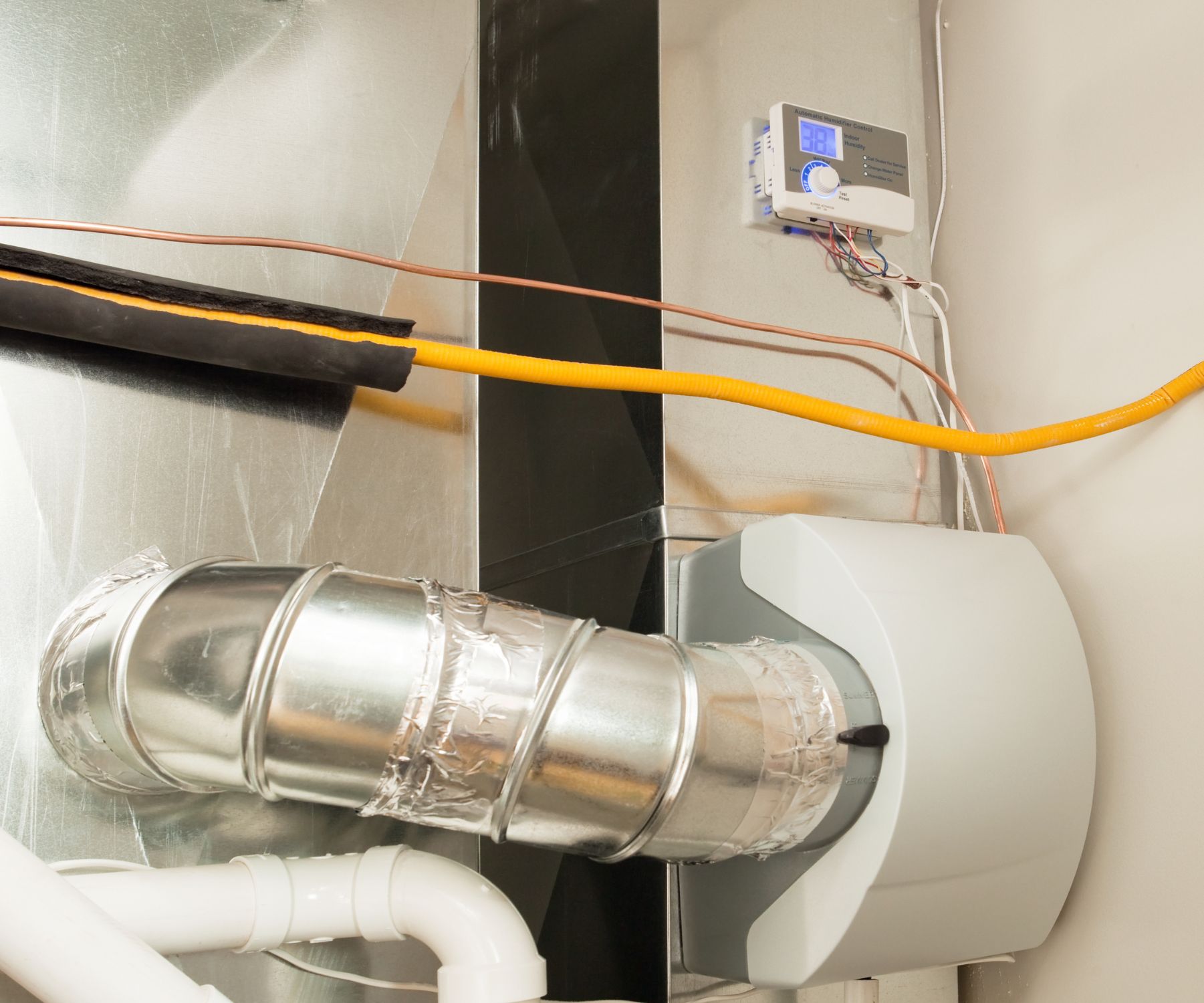Table of Contents
What is a Whole House Steam Humidifier?
A steam humidifier is a specialized type of whole-house humidifier that integrates directly into a home’s HVAC ductwork.
True to its name, it employs a steam-generation technique by boiling water to produce steam. This steam is then efficiently distributed throughout the entire house via the duct system, effectively increasing the humidity levels across all rooms.
This method not only ensures a uniform distribution of moisture but also provides precise control over the indoor humidity levels, making it an ideal solution for maintaining optimal indoor air quality and comfort throughout your home.
Benefits of using a steam humidifier:
Steam humidifiers offer a wide array of advantages over other types of humidifiers like evaporative and ultrasonic models, especially in the context of whole-house humidification.
However, a key benefit that truly sets steam humidifiers apart and boosts their popularity is their water boiling process. By heating water to create steam, these humidifiers naturally purify the water, significantly reducing the presence of mineral dust and eliminating germs.
This feature not only ensures a more consistent and efficient distribution of humidity throughout large areas but also provides a cleaner, healthier air quality, making steam humidifiers a preferred choice for maintaining optimal indoor comfort and health.
Types of steam humidifiers:
| Type | Description |
|---|---|
| Console humidifiers | Free-standing units with an internal reservoir, heating element, and fan to distribute steam. |
| Electrode humidifiers | Use electrodes in the water that boil the water to produce steam. |
| Canister humidifiers | Portable units with a removable water tank. |

| Feature | Steam Humidifier | Evaporative Humidifier | Ultrasonic Humidifier |
|---|---|---|---|
| Humidity Control | High precision | Moderate | Varies |
| Coverage | Whole house | Single room to whole house | Single room |
| Water Purification | Boiling process | Wick filter | None |
| Maintenance Frequency | Lower | Higher | Moderate |
| Operation Noise | Quiet | Can be noisy | Very quiet |
| Mineral Dust Production | None | Possible | Possible |
| Ideal Use | Large, integrated systems | Individual rooms or smaller homes | Individual rooms |
Steam humidifiers excel in large-scale applications, offering precise control and efficient performance without the drawbacks of mineral dust or frequent maintenance. Their quiet operation and ability to integrate into existing HVAC systems make them an ideal choice for comprehensive home humidification solutions.
Who can benefit from a steam humidifier?
A steam humidifier, particularly the whole-house variety that integrates with a home’s HVAC system, is best suited for specific circumstances where its unique advantages can be fully leveraged:
- Large Homes or Spaces: Given its capacity to distribute moisture evenly throughout extensive areas, a steam humidifier is ideal for larger homes where maintaining consistent humidity levels in every room is challenging.
- High Demand for Precise Humidity Control: In environments where maintaining an exact humidity level is crucial, such as homes with sensitive woodwork, artwork, or musical instruments, the precise control offered by steam humidifiers is invaluable.
- Cold Climates with Heavy Heating Use: In areas where the heating system is frequently used, indoor air can become extremely dry. Steam humidifiers can effectively counteract this by integrating with the heating system to provide necessary moisture.
- Health-Related Needs: For households with occupants who have severe respiratory issues, allergies, or skin conditions aggravated by dry air, the clean and consistent moisture output of a steam humidifier can provide significant relief.
- Integration with Smart Home Systems: For homeowners who prioritize smart home technology and seek seamless integration with existing HVAC systems for centralized control, steam humidifiers are an excellent fit due to their compatibility and efficiency.
- Areas with Hard Water: The boiling process of steam humidifiers can help minimize issues related to mineral buildup, making them a suitable option in regions with hard water, where other types of humidifiers might struggle or require frequent maintenance.
In these scenarios, the unique features of a steam humidifier—such as its ability to provide rapid, consistent, and controlled humidification over large areas—make it an optimal choice for effective whole-house humidity management.
Is it true that steam humidifiers are the best for avoiding the dangers of humidifiers mold and bacteria?
Like we briefly touched on before, there are some advantages to steam humidifiers when it comes to avoiding mold and bacteria, but they are not completely immune to these issues:
Steam humidifiers boil water, which can help kill mold spores and bacteria that might be in the water. However, this is only effective if the water reservoirs are cleaned regularly.
Steam humidifiers don’t require wicks or filters that can trap mineral deposits and microbes. However, the steam outlet and any surfaces the steam touches can still allow mold growth if not cleaned.
Steam humidifiers add dry steam to the air rather than cool mist, which is less likely to promote surface condensation that can lead to mold.
However, steam humidifiers still require proper maintenance to prevent mold and bacteria:
1.The water reservoir should be cleaned regularly with a disinfectant to kill any mold or bacteria.
2.Any surfaces the steam comes into contact with should be cleaned to prevent microbial growth.
Steam humidifiers, like other types, can spread microbes in the air if the water reservoir contains any contaminants. Always use clean water.
Are Steam Whole House Humidifiers better at avoiding mold and bacteria than the other types of whole house humidifiers?
Yes, in general steam humidifiers are better at avoiding mold and bacteria growth compared to other types of whole house humidifiers:
1.Evaporative humidifiers require wicks and filters that can promote mold growth if not cleaned regularly. The standing water is also prone to bacterial growth.
2.Ultrasonic and impeller humidifiers produce cool mists that can condense on surfaces and promote mold.
By contrast, steam humidifiers boil the water, killing many microbes. And they don’t require wicks or filters.
However, steam humidifiers are not foolproof:
If not cleaned regularly, mineral deposits can accumulate in the water reservoir and provide an environment for microbial growth.
Steam can condense on humidifier surfaces, allowing mold if not cleaned.
Adding steam to air can make dust particles and allergens airborne.
So while steam humidifiers have an advantage, proper maintenance is still crucial
Do You Need A Boiler Present?
Steam humidifiers do have higher energy demands compared to other types of humidifiers, which can make them more expensive to operate, especially if a boiler is not already present.
Here are some factors to consider regarding the costs of steam humidifiers:
Steam humidifiers require heating water to boiling temperatures, which uses more electricity than cool mist options. This can drive up energy bills.
Installing a steam humidifier without an existing boiler/furnace can require running new steam lines, condensed water returns, and installing a water heater to generate steam. This significantly increases upfront costs.
Without a boiler, standalone electric steam humidifier units are available, but energy costs may still be high depending on humidification needs.
Ongoing costs are higher as mineral deposits in hard water can cause scaling in steam humidifiers, requiring frequent maintenance and part replacement.
However, in a large home a steam humidifier may be the only option capable of properly humidifying the whole space. Their higher output can justify the costs.
In summary, for homes without an existing steam system/boiler, the costs of installing and operating a steam humidifier are often prohibitive.
Cool mist and evaporative options are more affordable.
But steam systems make sense for larger homes if the initial investment can be accommodated. As with any system, considering long term costs and benefits is advisable.
FAQ
How do steam humidifiers increase humidity?
Steam humidifiers boil water in a reservoir to produce water vapor or steam. This steam is dispersed into the air through a built-in fan or existing HVAC system ducts. As the steam evaporates in the air, it raises the humidity level.
What maintenance is required for steam humidifiers?
To avoid mineral deposits and microbial growth, steam humidifiers require:
– Daily water changes
– Regular cleaning/disinfecting of tanks
– Descaling agents to remove mineral deposits
– Replacement of filters, wicks, and gaskets
How often do steam humidifier filters need replacement?
Most manufacturers recommend replacing steam humidifier filters every 1-2 months of use. Hard water and frequent operation may require more frequent filter replacements.
Can steam humidifiers lead to mold growth?
Yes, steam humidifiers can promote mold growth if not properly maintained. Mold can grow in mineral deposits or on surfaces where steam condenses. Proper cleaning and disinfecting of tanks, filters, and surfaces is essential.
Are steam humidifiers safe for pets?
Steam humidifiers are generally safe for pets as long as hot surfaces are out of reach to avoid burns. The steam itself is not hazardous. Proper maintenance is key to avoid mold and bacteria that could pose a health risk.
How often should the water tank be cleaned in a steam humidifier?
The water tank or reservoir in a steam humidifier should be drained, cleaned and disinfected daily to help prevent mineral deposits and bacteria growth. Weekly deep cleanings are also recommended.
Can I use a steam humidifier in a bedroom?
Yes, steam humidifiers can be used in bedrooms, but precautions should be taken. Avoid very hot steam emissions. Place the unit far from beds and aim steam away from sleeping areas. Monitor humidity levels to avoid condensation.
Are steam humidifiers energy efficient?
No, steam humidifiers require boiling water so they typically use more energy than other types of humidifiers. Their energy efficiency can be improved by insulating steam lines, proper sizing, and using energy efficient models.
Does water quality affect a steam humidifier?
Yes, hard water with high mineral content can cause scale buildup in steam humidifiers. This requires more frequent maintenance. Using filtered or distilled water can help reduce deposits.
How can I prevent white dust from my steam humidifier?
White dust is caused by mineral deposits from hard water. Change water daily, use distilled or filtered water, clean scale buildup regularly, and replace filters as needed to prevent white dust.
Can I install a steam humidifier myself?
Steam humidifier installation is complex, especially if steam lines need to be run. Hiring a qualified HVAC technician is highly recommended unless you have expertise in steam system installation.


